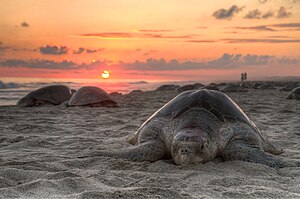Olive Ridley turtles, the fishermen of Orissa and the OMRCC
Contents
Olive Ridley Turtles, the fishermen of Orissa and the OMRCC
| The Olive Ridley turtles (Lepidochelys olivacea) are a species of sea turtles with nesting grounds all over the world. These turtles are classified as Vulnerable by the IUCN[1].As seen in the video alongside, these turtles are best known for their behavior of synchronized nesting in mass numbers (arribadas - Spanish for mass arivals). In the India Ocean, although the precise location keeps changing every year, the biggest nesting ground is near Gahirmatha in Orissa[2]. In 1991, over 600,000 turtles nested along the coast of Orissa in one week[3]. Genetic studies suggest that the population nesting here may be the ancestral population of all other global populations[4]. Unfortunately, in the last few decades, mechanized fishing and increasing human habitation have started to threaten these turtles. Between 1995 and 2005, over 100,000 Olive Ridley turtles were found dead on the beaches of Orissa[5].
One of the proposed solutions was to establish a sanctuary in the area; but the shifting location of the mating grounds made this solution unfeasible. Conservationists realized early on that the main problem was implementation of existing laws - especially the 1983 Orissa Marine Fisheries Regulation Act[6], according to which mechanized fishing was prohibited within 5-10 kms of the coast, depending on boat size. Nevertheless, several trawlers fished illegally near the mating grounds, mistakenly catching the turtles in their nets. The fishermen here depend on their fishing catch for a majority of their income. The advent of mechanized trawlers naturally led to higher volumes of catch, however, during the mating season, it also set up a serious threat for the Olive Ridley turtles. The ancestors of these fisherfolk must have seen these turtles coming here for over a millennium, but technological developments over no more than 10-15 years ended up threatening the very survival of these beautiful creatures! It was even more unfortunate that the push by conservationists to save the turtles further alienated the indigenous communities, some of whom had previously spoken in favor of conservation[5]. Even fishermen with non-mechanized boats joined ranks with the trawler-owners, since they perceived the conservation movement as anti-fishing, which was not the case. Several groups such as ATREE started working hard to remove this misconception. In December 2004, ATREE organized a meeting in Bhubaneshwar that was attended by NGOs such as WWF and Greenpeace, traditional fishermen unions and local community organizations. The group - later named the Orissa Marine Resources Conservation Consortium (OMRCC) - carried out several activities and advocacy efforts to achieve common conservation goals, including education and sensitization of the local folk about the Olive Ridleys[5]. The OMRCC has also played a significant role in planning policies for coastal protection such as establishment of Coastal Regulatory Zones and protection of livelihoods of local fishing communities [7][8]. The OMRCC model highlights the importance of involving the local communities and stakeholders in making policies for conservation. |
|
References
- ^ IUCN 3.1 Olive Ridley Turtle Accessdate = Oct 2, 2011
- ^ Plotkin, P. (2007). Biology and conservation of ridley sea turtles, (Ed.), Baltimore, Maryland: The Johns Hopkins University Press.
- ^ National Marine Fisheries Service and U.S Fish and Wildlife Service.(1998). Recovery Plan for U.S Pacific Populations of the Olive Ridley Turtle (Lepidochelys olivacea). National Marine Fisheries Service, Silver Spring, MD.
- ^ Shanker K, Pandav B, Choudhury BC (2004) An assessment of the olive ridley turtle (Lepidochelys olivacea) nesting population in Orissa, India. Biol Conserv 115: 149–160.
- ^ a b c Shanker K, Hiremath A, Bawa K (2005) Linking Biodiversity Conservation and Livelihoods in India. PLoS Biol 3(11): e394. doi:10.1371/journal.pbio.0030394
- ^ 1983 Orissa Marine Fisheries Regulation Act
- ^ Submission by the Orissa Marine Resources Conservation Consortium (OMRCC) – “Proposal to Improve CRZ Notification of 1991 and the livelihood security of fishing communities ORISSA MARINE RESOURCES CONSERVATION CONSORTIUM, January 16, 2010
- ^ Rushikulya Rookery
Comments
blog comments powered by DisqusMore notes like this
| |||||||||||||||||||||||||||||||||||||||||||||||||||||||||||||||||||||||||||||||||||||
Only 15 articles are shown in this list. A total of 64 articles in the database as of this moment. For the complete list, click on further results on the bottom right corner of the above table.
Semantic tags
- Browse all Semantic Tags associated with this page
- Find more pages and articles created by the community by clicking this link.
| Title | Olive Ridley turtles, the fishermen of Orissa and the OMRCC | Article is on this general topic | Locals vs conservation | Author | Gaurav Moghe |
|---|---|---|---|---|---|
| Specific location(s) where study was conducted | Not noted | General region where study was conducted | Not noted | State where study was conducted | Orissa |
| Institutional affiliation | Not noted | Institution located at | Not noted | Institution based around | Not noted |
| Species Group | Reptiles | User ID | User:Gauravm | Page creation date | 2011/10/18 |
Share this page:
